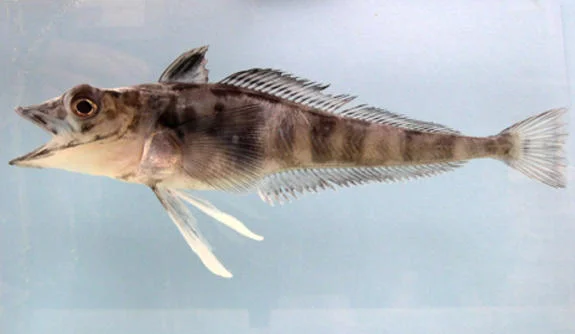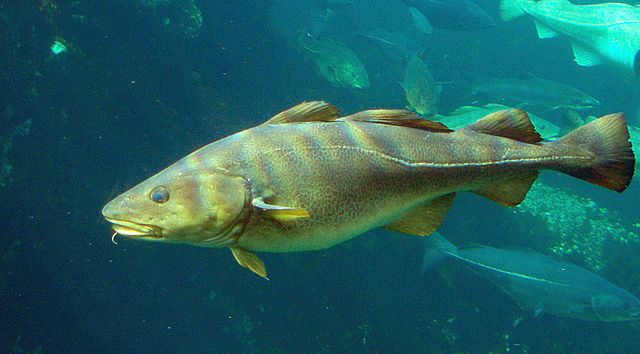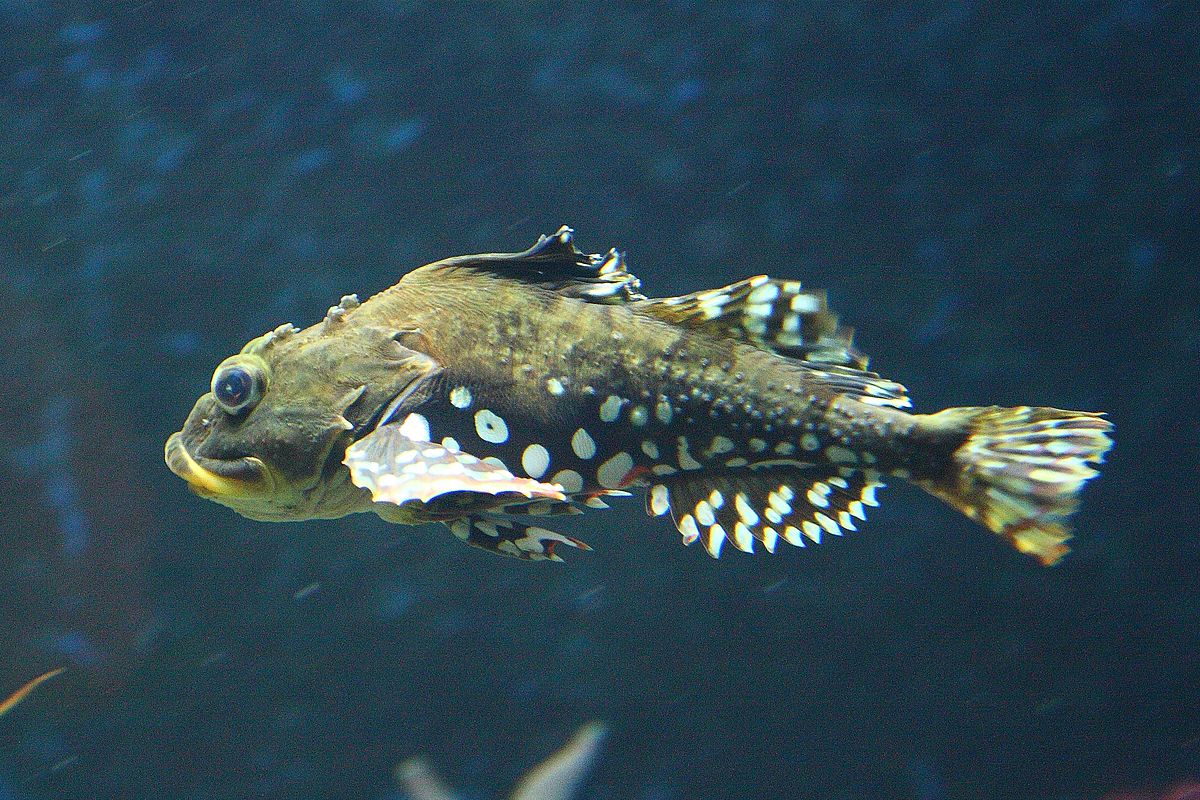Structural Characteristics of Antifreeze Proteins (AFP) and Glycoproteins (AFGP)
NATURAL SOURCES
AFGP: ANTARCTIC NOTOTHENOID
Trematomus nicolai
DESCRIPTION
Trematomus nicolai is named after the zoologist, Nicolai Hanson, a member of the 1899 Borchgrevink expedition to Antarctica. The members of this expedition were the first explorers to spend any amount of time in the Antarctic studying marine life. Ongoing conservation work has restored their isolated and snow-damaged hut , the first permanent structure on the continent. This hut now stands as a silent memorial to Nicolai Hansen, the first human to be buried in Antarctica. Knowing that he did not have long to live, he requested that he be buried high atop the ridge overlooking Cape Adare and the sea. His gravesite, which is extremely hard to access, is marked by a small cross.
Distribution
Members of the suborder notothenioidei are primarily confined to the Antarctic region where they dominate, accounting for approximately two-thirds of the fish species, and 90 percent of the individual fish in the area.
Trematomus nicolai can be considered a typical notothenioid. The environment occupied by the Antarctic notothenioids is one of the most harsh on the planet. The average yearly temperature in McMurdo Sound is -1.87 degrees Celsius, with the range varying from -1.4 and -2.15 degrees Celsius. Not only is it extremely cold, but it is also heavily ice laden. While some notothenioid species have developed the ability to live efficiently in middle-level waters by developing neutral buoyancy, the majority of species are bottom dwelling. Trematomus nicolai lives, feeds and reproduces near the sea floor. It is found down to 50 m - in fairly shallow water close to the surface ice. The ability to produce considerable quantities of antifreeze glycoproteins is an essential feature for survival under such life-threatening conditions.
Habitat
Antifreeze Production: AFGP
Like the northern cods, Antarctic notothenioids produce antifreeze glycopeptides. Unlike the Atlantic cod, the notothenioids retain their AFGP (antifreeze glycoproteins) year-round.
Eastman,J.T. and A.L.DeVries. 1989 Antarctic Fishes. Chapter 4, pp 49-58. In: Life at the Edge - Readings from Scientific American. eds Gould, J.L. & C.G.Gould. W.H. Freeman and Co. NY
REFERENCE
AFGP: ATLANTIC COD
Gadus morhua
DISTRIBUTION
Atlantic cod occur on both sides of the North Atlantic. In the eastern North Atlantic, cod stocks are distributed from Iceland to the Norwegian Sea, to the Barents Sea and Spitsbergen, and southward to the Baltic Sea and Bay of Biscay. In the western North Atlantic, their geographic range is from Greenland and southern Baffin Island, along the continental slope off Labrador, Newfoundland, the Gulf of St Lawrence, the Grand Bank and Scotian Shelf, Bay of Fundy-Gulf of Maine, and southward to Cape Hatteras, North Carolina (lat 35°10' N). Throughout the range of distribution, there are many different and identifiable cod stocks, each with its own set of characteristics.
Atlantic cod inhabit cool-temperate to subarctic waters from inshore regions to the edge of the continental shelf. Although cod are adapted for bottom feeding, they can be found at any depth between the surface waters and the sea bed. Their preferred temperature range is from -0.5 to 10 degrees Celsius, although this can vary with time of year, geographic location, and size of fish.Cod have also been reported making incursions into waters outside their preferred range in order to feed on capelin or other prey, or during periods of migration.
Atlantic cod tend to move in schools and, in some areas at least, they move offshore in winter and onshore in summer. They can travel great distances during their migrations, possibly the greatest recorded distance travelled by a tagged cod being from the central North Sea, to the Grand Bank off the Canadian coast, a distance of over 3228 km.
HABITAT
FOOD
As fry, cod feed on a variety of small creatures such as copepods, amphipods, and barnacle larvae. Juveniles and young adults continue to eat crustaceans such as euphausiids, mysids, shrimps, small lobsters, spider crabs, and hermit crabs. As they reach adulthood, fish, such as capelin, herring and sand lance, becomes the predominant food.
Atlantic cod can attain great size - up to and over 100 cm - under favorable conditions. Size at age, and maximum size depend on a variety of environmental conditions. In recent times, large cod have become more and more scarce.
ANTIFREEZE PRODUCTION:
AFPG
To date, the only populations of Atlantic cod to be examined for antifreeze production are those found off the east coast of Canada. Adult cod produce antifreeze glycoproteins in response to sub-zero water temperatures, with photoperiod playing only a minor role in control of production.
Fletcher,G.L., M.J.King, and M.H.Kao. 1987. Low temperature regulation of antifreeze glycopeptide levels in Atlantic cod (Gadus morhua). Canadian Journal of Zoology: 65, 227-233.
REFERENCE
AFGP: GREENLAND COD
Gadus ogac
DISTRIBUTION
Also known as the rock cod, ogac, uvac, and pilot, the Greenland cod occurs from Alaska, along the Arctic coast of Canada, round to Greenland, and southward into Hudson Bay, Ungava Bay and the Hudson Strait, along the Labrador coast to Newfoundland, through the Strait of Belle Isle and into the Gulf of St Lawrence, and further south to Bras d'Or Lake and Cape Breton, NS.
HABITAT
Greenland cod inhabit cold temperate to arctic waters, usually in inshore regions in the northern part of the range. Along the Labrador coast, this species is the most common type of codfish to be found in harbours and fjords, occurring less commonly in offshore waters.
FOOD
In Greenland waters, the Greenland cod eats mainly fishes, especially capelin, Arctic cod, smaller Greenland cod, and Greenland halibut. Among the invertebrates, amphipods, shrimps, crabs, molluscs, and polychaete worms are commonly eaten. Gadus ogac is similar in appearance to the Atlantic cod, but is generally smaller and rounder, and with somewhat different (darker) colouration both externally and internally.
ANTIFREEZE PRODUCTION:
AFGP
The seasonal cycle of antifreeze production in Gadus ogac has yet to be documented. However, it seems likely that antifreeze is produced during the winter months in response to environmental stimuli and is lost from the plasma and other extracellular fluids during the warmer summer months (as is the case with the Atlantic cod, Gadus morhua).
REFERENCES
Van Voorhies, W.V., J.A.Raymond, and A.L.DeVries. 1978. Glycoproteins as biological antifreeze agents in the cod, Gadus ogac (Richardson). Physiological Zoology. 51: 347-353.
O'Grady,S.M., J.D.Schrag, J.A.Raymond, and A.L.DeVries. 1982. Comparison of antifreeze glycopeptides from Arctic and Antarctic fishes. Journal of Experimental Zoology. 224: 177-185.
AFP TYPE I: WINTER FLOUNDER
Pleuronectes americanus
DISTRIBUTION AND HABITAT
The winter flounder, also known as the blackback flounder, can be found from south Labrador and along the eastern seaboard of Canada and the USA as far south as Georgia. It lives inshore, in relatively shallow water (generally between 2 - 40 m depth), and can be found inhabiting soft muddy to moderately hard bottoms, although sandy bottoms are preferred. Young fish inhabit shallower water than older, larger ones. Some populations of winter flounder appear to undertake limited onshore-offshore migrations, moving offshore in winter and onshore in summer. However, they are tolerant of a wide range of temperatures and can be found in winter in the coastal waters of Newfoundland, in water temperatures as low as -1.8 degrees Celsius.
FOOD
Winter flounder are sight feeders. They hunt mainly during daytime, and consume a variety of bottom-dwelling organisms including polychaete worms, bivalves, gastropods, and crustaceans. Flounder seldom exceed 45 cm in length, and most adults are in the 30 - 40 cm size range.
ANTIFREEZE PRODUCTION
Studies of winter flounder antifreeze production have been carried out with animals collected from Newfoundland and New Brunswick coastal waters. These animals spend their winters inshore in very cold icy waters and, consequently, are obliged to produce antifreeze or risk freezing to death. Onset of antifreeze production is under the control of photoperiod, with temperature playing a role in the level of antifreeze built up in the plasma and extracellular fluids during the winter.
REFERENCES
Fletcher, G.L. 1981. Effect of temperature and photoperiod on the plasma freezing point depression, C1- concentration, and "antifreeze" in winter flounder. Canadian Journal of Zoology: 60, 348-355.
Fletcher, G.L., D.R. Idler, A. Vaisius, and C.L. Hew. 1989. Hormonal regulation of antifreeze protein gene expression in winter flounder. Fish Physiology and Biochemistry: 7, 387-393.
AFP TYPE I: Shorthorn Sculpin
Myoxocephalus scorpius
DISTRIBUTION
Also known as the daddy and Greenland sculpin, these sculpins are widely distributed in northern waters on both sides of the North Atlantic Ocean and in the arctic oceans. They occur round Greenland, Iceland, Spitsbergen, and in the Barents Sea off Novaya Zemlya, Siberia. From northern Europe they are distributed south to the Bay of Biscay. They can be found round Alaska, along the Arctic coast of Canada through to Hudson Bay and Baffin Island, and southward down the coast of Labrador, the Gulf of St Lawrence, off Newfoundland, throughout the Bay of Fundy, and around the coast of Nova Scotia.
HABITAT
The shorthorn sculpin is a sluggish benthic species usually found in cool, shallow waters over smooth and weedy bottoms, in depths to approximately 40 m. Shorthorns are often caught around wharves, where they search for food. When disturbed, the shorthorn moves slowly and for only a short distance, using the large pectoral fins to propel it through the water in a motion resembling flying.
FOOD
Shorthorn sculpins are voracious feeders, eating crabs, shrimps, sea urchins, and other organisms. They may also eat herring, gobies, small cod, and marine worms. Sculpins almost 80 cm long have been reported, but this is very rare, and most fall within the 30-50cm size range.
ANTIFREEZE PRODUCTION:
AFP TYPE I
The cycle of antifreeze production in the shorthorn sculpin is much like that in the winter flounder, another producer of Type I antifreeze protein in the north Atlantic. Antifreeze appears in the plasma in November, peak antifreeze levels are reached early in the year (Jan-Feb), remain high through the winter, and gradually decline to a minimum by August-September.
REFERENCES
Hew,C.L., G.L.Fletcher, and V.S.Ananthanarayanan. 1980. Antifreeze proteins from the shorthorn sculpin, Myoxocephalus scorpius: isolation and characterization. Canadian Journal of Biochemistry. 58: 377-388.
AFP TYPE II: SEA RAVEN
Hemitripterus americanus
DISTRIBUTION
The sea raven, also known as the whip sculpin, gurnet, puff-belly, scratch-belly, and sea hen, ranges along the Atlantic coast of North America from Hamilton Inlet, Labrador, southward to Strait of Belle Isle and Gulf of St Lawrence. Sea Raven are present but uncommon around Newfoundland, becoming more common in Nova Scotia waters, in the Bay of Fundy and embayments such as Passamaquoddy Bay, and southward to Chesapeake Bay.
HABITAT
Sea ravens live on rocky or hard bottoms, occasionally swimming up to the surface waters. Most live in waters deeper than 2 m and more shallow than 90 m. Preferred water temperatures range from the upper limit of about 14 degrees Celsius (eg. in the Gulf of Maine) to near the freezing point of salt water (-1.8 degrees Celsius) eg. off Newfoundland and in the southern Gulf of St Lawrence.
FOOD
Sea ravens are voracious feeders, and will eat any available bottom invertebrates, including crustaceans and molluscs. Sea urchins have been found in the stomachs of sea ravens taken in Newfoundland waters. Their wonderful camouflage comes in useful when they stalk and capture other fishes such as herring, sand lance, and silver hake. Interestingly, when they themselves are captured, sea ravens will often distend their abdomens by gulping water or a mixture of water and air and may then float belly up. The water can usually be removed by burping these fish (taking care not to get the fingers bitten), after which, they will be able to swim normally. Although sea ravens can reach lengths greater that 60cm, adults around 30 cm are more commonly found.
ANTIFREEZE PRODUCTION:
AFP TYPE II
Antifreeze production in this species shows some interesting variations from the pattern commonly found in species occupying temperate waters. Firstly, sea raven have antifreeze proteins present in their plasma year-round. Secondly, while some individuals show a seasonal cycle of antifreeze production with levels increasing to maximum values in the winter (like ocean pout), other individuals have constantly high levels all year round. This pattern is most commonly observed in fish inhabiting polar oceans. However, the animals used in studies that established this pattern in sea raven came from New Brunswick - Atlantic Canadian - waters, which although cool, are certainly not polar!
REFERENCES
Fletcher,G.L., M.H.Kao, and K.Haya. 1984. Seasonal and phenotypic variation in plasma protein antifreeze levels in a population of marine fish, Sea Raven (Hemitripterus americanus). Canadian Journal of Fisheries and Aquatic Sciences. 41: 819-824.
Ng,N.F.L., and C.L.Hew. 1992. Structure of an antifreeze polypeptide from the sea raven - disulphide bonds and similarity to lectin-binding proteins. Journal of Biological Chemistry. 267: 16069-16075.
AFP TYPE II: SMELT
Osmerus mordax
DISTRIBUTION
Like the Atlantic salmon, the rainbow smelt is an anadromous species - it lives in the sea for part of its life cycle and reproduces in fresh water. It is primarily an inshore species, occurring in bays and estuaries along the North American Atlantic coast, from the Hamilton Inlet - Lake Melville estuary of Labrador, and it can be found along the eastern seaboard of North America, as far south as New Jersey. Smelts occur sparingly in Labrador but may be numerous at times in the coastal waters around Newfoundland. They can be found in most estuaries of the Gulf of St Lawrence region of Quebec (especially the North Shore), New Brunswick, and Nova Scotia; and around coastal Nova Scotia and the Bay of Fundy waters of Nova Scotia and New Brunswick. Smelt can also be found landlocked in many freshwater lakes of the coastal provinces of Canada and eastern North America where they can live successfully throughout the life cycle. In the Great lakes, populations have developed as a result of introductions into Crystal Lake, MI. The rainbow smelt has subsequently spread through the Great Lakes, where it is often an abundant species.
HABITAT
The rainbow smelt, is also commonly known as the American smelt, Atlantic smelt, leefish, frostfish, and icefish. They ascend freshwater streams in spring to spawn and are often seen in large shoals in estuaries and rivers during the spawning migrations. Smelt prefer cooler waters during the warm months and tend to move offshore to live in deeper water in summer. Little is known of the marine portion of the life history, although there is some evidence of migrations in the sea. One smelt, tagged at Portage Island in Miramichi Bay, NB, was caught 161 km away in upper Chaleur Bay. Smelt enter estuaries in the fall and late winter months where they may encounter very low temperatures and consequently produce antifreeze proteins.
FOOD
Rainbow smelt are carnivorous and voracious fish, eating a variety of invertebrate species, and, as they grow, any available small fishes (eg. silversides, mummichogs, and herring). Most mature smelt are in the 12-20cm size range, although individuals greater than 35 cm have been reported.
ANTIFREEZE PRODUCTION:
AFP TYPE II
Although the full seasonal cycle of antifreeze production in smelt has yet to be documented, measurements and sample collection from the wild suggest that smelt follow the typical pattern of antifreeze production seen in fish inhabiting temperate waters - production of antifreeze during the winter months, followed by its loss over the summer.
REFERENCES
Ewart,K.V. and G.L.Fletcher. 1990. Isolation and characterization of antifreeze proteins from smelt (Osmerus mordax) and Atlantic herring (Clupea harengus harengus). Canadian Journal of Zoology. 68: 1652-1658.
AFP TYPE II: HERRING
Clupea harengus harengus
DISTRIBUTION
The Atlantic herring (also known as the sea herring, sardine, bloater or kipper when smoked, Digby chick, skadlin, scaidhlin or scaithlin when salted and smoked) can be found on both sides of the North Atlantic. In the eastern North Atlantic, it occurs off Iceland and the intervening seas to Europe, where it ranges from Spitsbergen and the White Sea to the Strait of Gibraltar. It occurs in the Baltic Sea to the Gulf of Bothnia and to the Gulf of Finland. In the western North Atlantic this species can be found from western Greenland to Labrador, and southward along the North American coast to Cape Hatteras.
HABITAT
The Atlantic herring is primarily pelagic, and is often found in schools (sometimes huge), occurring in shallow inshore waters, or offshore from the surface down to depths of 200m. A number of separate populations or stocks have been described occurring in Canadian and adjacent waters. Each stock seems to have preferred spawning and feeding and overwintering grounds, and tagging studies have demonstrated the existence of annual migratory patterns between these areas.
FOOD
Atlantic herring are visual feeders, and consuming plankton during daylight hours, filtering the small organisms out of the sea water with their long, well-developed gill rakers. Young herring first feed on small phytoplankton, and progress to larger organisms as they grow. Adult herring rely heavily on the euphausiid crustacean Meganyctiphanes norvegica, but may also eat copepods, fish eggs, pteropods, mollusk larvae, and the larvae of small fishes such as sand lance, silversides, herring, and capelin. Herring are relatively small fish, rarely exceeding 40 cm in length.
ANTIFREEZE PRODCUTION:
AFP TYPE II
The seasonal cycle of antifreeze production in the herring has not yet been well documented. However, it seems likely that antifreeze is produced during the winter months in response to environmental stimuli and is lost from the plasma and other extracellular fluids during the warmer summer months (as is the case with many other fish species inhabiting a sub-polar/temperate range).
REFERENCES
Chadwick, E.M.P., D.K.Cairns, H.M.C.Dupuis, K.V.Ewart, M.H.Kao, and G.L.Fletcher. 1990. Plasma antifreeze levels reflect the migratory behaviour of Atlantic herring (Clupea harengus harengus) in the southern Gulf of St. Lawrence. Canadian Journal of Fisheries and Aquatic Sciences 47: 1534-1536.
Ewart, K.V. and G.L. Fletcher. 1993. Herring antifreeze protein: primary structure and evidence for a C-type lectin evolutionary origin. Molecular Marine Biology and Biotechnology. 2: 20-27.
AFP TYPE III: OCEAN POUT
Credit: Andy Martinez, Stellwagen Bank National Marine Sanctuary
Marcrozoarces americanus
DISTRIBUTION
The ocean pout, also known as the eelpout, muttonfish, and 'congo eel', can be found in the western North Atlantic Ocean from the vicinity of Battle Harbour, southern Labrador, into the Gulf of St Lawrence, all around the coast of Newfoundland, off Nova Scotia, in the Bay of Fundy, and as far south as North Carolina.
HABITAT
The ocean pout is a bottom dwelling fish, occupying a variety of depths from the intertidal zone down to over 180 m. Pout can be found over all bottom types, but seem to prefer hard and semi-hard substrates to muddy bottoms. They can be found occupying a wide range of temperatures, from sub-zero environments to temperatures as high as 16 degrees Celsius. Seasonal migrations between deeper water in autumn and shallower waters in spring have been reported for this species, and an inshore-offshore migration has also been reported to occur in the eastern Newfoundland area, the fish moving inshore in spring, presumably to spawn.
FOOD
Ocean pout feed on a wide variety of bottom-dwelling creatures. They feed by scooping up mouthfuls of sediment from a resting position on the bottom. From these gulps of sediment, food is extracted, and prey organisms are generally invertebrates and occasional small fishes such as herring and smelt. Ocean pout are known to feed on marine worms, sea urchins, brittle stars, sand dollars, crabs, shrimp, amphipods, barnacles, mussels, whelks, periwinkles, scallops, and sea squirts. They have been known to reach lengths greater than 100 cm, but this is unusual and adult pout are more commonly between 30-60 cm in length.
ANTIFREEZE PRODUCTION:
AFP TYPE III
Ocean pout have relatively high concentrations of Type III antifreeze in their plasma year round. However, the winter concentrations are considerably higher than those recorded during the summer months. There is also strong evidence for differences in the pattern of antifreeze production in different populations of ocean pout, which are related to the severity of winter encountered by those different populations.
REFERENCES
Fletcher, G.L., C.L.Hew, X. Li, K.Haya, and M.H.Kao. 1985. Year-round presence of high levels of plasma antifreeze peptides in a temperate fish, ocean pout (Macrozoarces americanus). Canadian Journal of Zoology. 63: 488-493
Hew, C.L., D.Slaughter, S.B.Joshi, G.L.Fletcher, and V.S.Ananthanarayanan. 1984. Antifreeze polypeptides from the Newfoundland ocean pout, Macrozoarces americanus: presence of multiple and compositionally diverse components. Journal of Comparative Physiology B. 155: 81-88.
AFP TYPE III: WOLFFISH
Anarhichas lupus
DISTRIBUTION
Also known as the catfish, striped wolffish, and ocean wolffish, the Atlantic wolffish can be found on both sides of the Atlantic Ocean. In the eastern Atlantic, these fish inhabit waters from Iceland, the Faroes, Spitsbergen, the White Sea, and the Murman coast, south to the British Isles and the western coast of France. In the western North Atlantic they can be found from west Greenland, across to southern Labrador and all along the Atlantic coast of Canada to the USA, and have been reported as far south as New Jersey.
HABITAT
The Atlantic wolffish is a solitary species, commonly inhabiting deep water along slopes, and not generally given to long migrations. While wolffish may live alone for much of the time, spring inshore migrations in preparation for summer spawning have been reported in a variety of areas eg. Nova Scotia, Newfoundland (conversely, in the Barents Sea, wolffish have been found close to shore at depths of 1-2 m in early spring and concentrated in deeper water during summer). Once inshore, mature Atlantic wolffish have been observed at depths of 5-15 m, where they can be found in holes under large boulders, swimming in open water, or resting on the bottom. One theory states that immature Atlantic wolffish (less than 50cm) must inhabit water deeper than 30 m and do not enter shallow inshore waters until sexually mature. There seems to be variation in depth, temperature and bottom type preferred. In the Newfoundland area, Atlantic wolffish occur over hard clay bottoms, in depths from 100-350 m and at bottom temperatures of -0.4 C to 4.0 C. Trawling experiments off west Greenland have shown Atlantic wolffish to be most commonly caught at depths less than l00 m and in a wide temperature range from -1.0 C to 10 C.
FOOD
Atlantic wolffish feed primarily on bottom dwelling invertebrates, such as echinoderms, molluscs, and crustaceans. The external skeletons of the prey are usually crushed, and, in addition to food, wolffish stomachs are frequently found to contain sand, silt, and stones. In spite of this rather unappetizing diet, wolffish can attain considerable size (maximum recorded size in Canadian waters = 124 cm). However, as with all fish species, their rate of growth is dependent on a variety of environmental factors. In sub-arctic waters, average length at age 5 years = 24 cm, at age 10 = 49 cm, and at age 15 = 70 cm.
ANTIFREEZE PRODUCTION:
AFP TYPE III
Other than the fact that these fish produce Type III antifreeze, little is known about the pattern of antifreeze production in Atlantic Wolffish.
REFERENCES
Scott,G.K., P.H.Hayes, G.L.Fletcher, and P.L.Davies. 1988. Wolffish antifreeze protein genes are primarily organized as tandem repeats that each contain two genes in inverted orientation. Molecular and Cellular Biology. 8: 3670-3675.





















